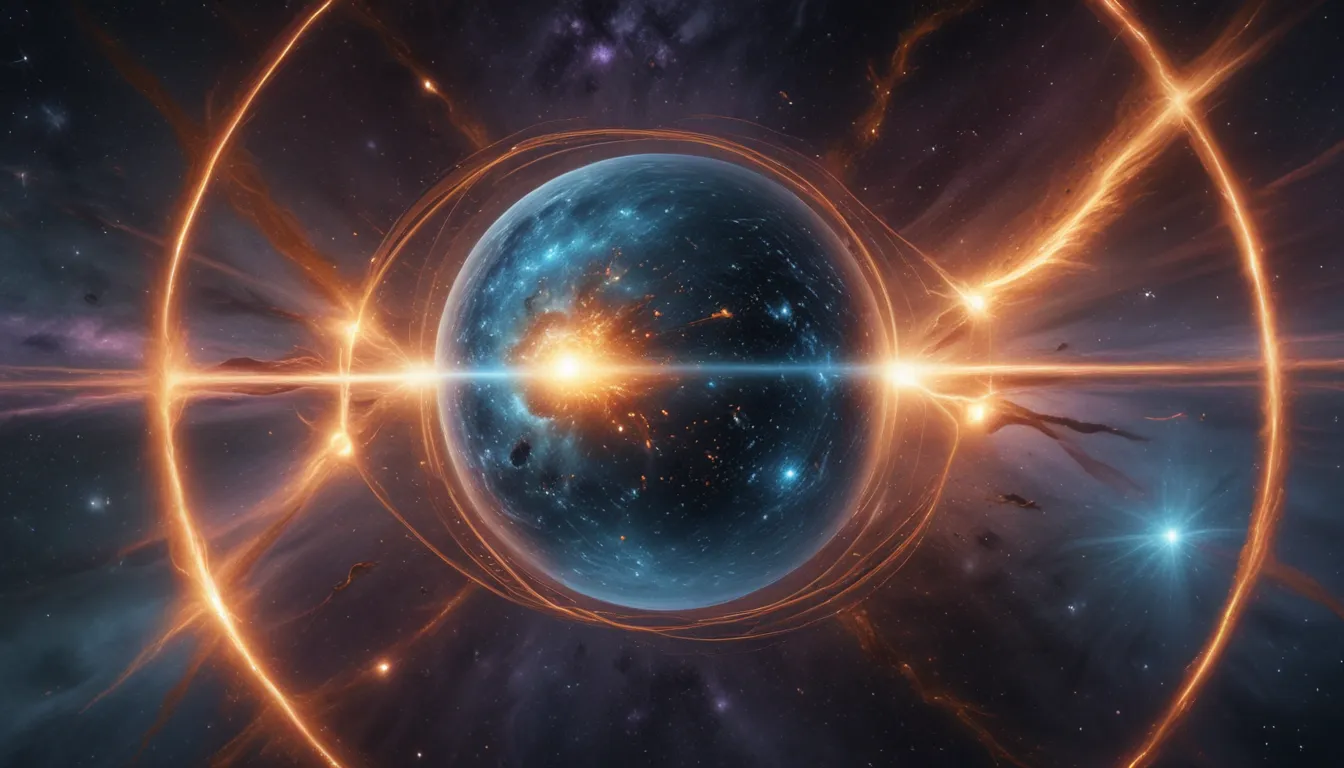A Note About Images: The images used in our articles are for illustration purposes only and may not exactly match the content. They are meant to engage readers, but the text should be relied upon for accurate information.
High-energy astrophysics delves into the most energetic and enigmatic phenomena in the universe. From the powerful emissions of black holes to the pulsating signals of neutron stars, this field of study offers a glimpse into cosmic events that shape our understanding of the cosmos. By utilizing advanced telescopes and detectors, scientists explore gamma rays, X-rays, and cosmic rays, revealing the extreme conditions where matter and energy interact, and uncovering the fundamental laws of physics. Let’s embark on a journey through 25 captivating facts about high-energy astrophysics, illuminating the powerful forces and objects that dominate the vast expanse of the universe.
Understanding High-Energy Astrophysics
High-energy astrophysics concentrates on unraveling the behavior of objects in space that emit highly energetic radiation. This realm includes fascinating phenomena such as black holes, neutron stars, and supernovae. Scientists in this field utilize various telescopes and instruments to detect X-rays, gamma rays, and cosmic rays, which are far more energetic than visible light.
- High-energy astrophysics studies the most energetic phenomena in the universe.
- Observing X-rays, gamma rays, and cosmic rays is at the core of high-energy astrophysics research.
Observing the Universe’s Highest Energy Events
Observing the high-energy universe poses a unique challenge due to Earth’s atmosphere absorbing much of this energetic radiation. As a result, scientists rely on satellites and space telescopes like the Chandra X-ray Observatory and the Fermi Gamma-ray Space Telescope to detect and study these emissions.
- Earth’s atmosphere absorbs most high-energy radiation, necessitating space-based observatories.
- Satellites such as Chandra and Fermi play a pivotal role in studying high-energy astrophysical phenomena.
The Enigmatic World of Black Holes
Black holes stand as one of the most intriguing subjects in high-energy astrophysics. These regions in space possess intense gravitational forces that prevent even light from escaping. The accretion disk surrounding a black hole emits high-energy radiation as matter gets pulled in and heated to extreme temperatures.
- Black holes emit high-energy radiation from their accretion disks.
- They serve as key subjects in high-energy astrophysics research.
Unraveling Extreme Cosmic Events
Supernovae and gamma-ray bursts represent some of the most extreme occurrences in the universe. Supernovae are colossal explosions signifying the end of a star’s life, while gamma-ray bursts are intense flashes of gamma rays believed to stem from massive star collapses or neutron star mergers.
- Supernovae are massive stellar explosions emitting high-energy radiation.
- Gamma-ray bursts rank as the brightest electromagnetic events in the universe.
Neutron Stars: Dense Remnants of Cataclysmic Events
Neutron stars, remnants of supernovae explosions, are immensely dense celestial bodies with powerful magnetic fields. These stars emit radiation beams from their magnetic poles, creating pulsating signals known as pulsars when these beams sweep past Earth.
- Neutron stars are dense remnants of supernovae events.
- Pulsars, emitted by neutron stars, can be detected from Earth.
Cosmic Rays: Energetic Particles Roaming Space
Cosmic rays are high-energy particles traveling through space at nearly light speed, comprising primarily of protons and atomic nuclei. Despite being discovered over a century ago, the sources of the most energetic cosmic rays remain largely unknown, believed to originate from beyond our solar system.
- Cosmic rays are high-energy particles pervading space.
- The origins of the most energetic cosmic rays continue to be a mystery.
The Future of High-Energy Astrophysics: Advancements and Insights
Technological advancements and evolving methodologies continue to expand the boundaries of our observation and comprehension of the high-energy universe. Upcoming missions and telescopes, such as the James Webb Space Telescope, hold the promise of delving deeper into the workings of the universe’s most energetic phenomena.
- Technological progress is enhancing our understanding of high-energy astrophysics.
- Future missions are poised to unveil more secrets of the energetic universe.
Gaining Insights Through High-Energy Astrophysics
High-energy astrophysics serves as a cornerstone of our comprehension of the universe. By studying the most energetic events and objects in space, scientists can glean insights into the fundamental workings of the cosmos. This field not only sheds light on the extreme aspects but also reveals universal laws that govern the vast expanse of space.
- High-energy astrophysics helps us understand the fundamental processes of the universe.
- Studying high-energy phenomena provides valuable insights into universal laws.
Influence of High-Energy Astrophysics on Diverse Scientific Fields
Discoveries in high-energy astrophysics hold profound implications for various other scientific disciplines, including particle physics, cosmology, and planetary science. By uncovering the high-energy processes within the universe, scientists can apply this knowledge across different domains, enriching our understanding of the natural world.
- High-energy astrophysics findings impact a wide range of scientific fields.
- They contribute to enriching our comprehension of the natural world.
Navigating Challenges and Embracing Opportunities
Exploring the universe’s most energetic phenomena presents its set of challenges, encompassing technical hurdles in observing high-energy radiation and theoretical complexities in explaining these phenomena. Each challenge acts as a catalyst for discovery and innovation, propelling the field forward and broadening our cosmic horizons.
- Technical challenges in observing high-energy radiation pose obstacles.
- Theoretical challenges foster innovation and exploration in the field.
The Power of International Collaboration in High-Energy Astrophysics
High-energy astrophysics thrives on international collaboration, leveraging the resources and expertise of multiple countries in observatories and space missions. Joint efforts involving organizations such as the European Space Agency (ESA) and NASA have led to significant discoveries and advancements in deepening our understanding of the high-energy universe.
- International collaboration is vital for advancing high-energy astrophysics.
- Collaborative missions have resulted in groundbreaking discoveries.
Educating and Inspiring Through High-Energy Astrophysics
Educating the public and nurturing aspiring scientists in high-energy astrophysics are pivotal for the field’s progression. Outreach programs and educational initiatives can ignite the curiosity of a new generation of astronomers and astrophysicists, ensuring the continued exploration of the universe’s most energetic phenomena.
- Public outreach and education are crucial for the field’s future.
- Inspiring future astronomers ensures ongoing exploration and discovery.
Technology’s Integral Role in High-Energy Astrophysics
The development in high-energy astrophysics closely intertwines with technological advancements. From sophisticated telescopes to advanced data analysis algorithms, technological innovations empower scientists to conduct detailed observations of the universe and unlock complex astrophysical puzzles.
- Technological progress enables detailed exploration of the universe.
Embracing the Wonders of the Cosmos
Embarking on a cosmic adventure through high-energy astrophysics unveils the mysteries of black holes, pulsars, and gamma-ray bursts, offering a peek into the universe’s most energetic phenomena. These 25 enriching facts merely scratch the surface, showcasing the immense power and elegance of our cosmos. High-energy astrophysics is not exclusive to astronomers; it acts as a portal for anyone intrigued by the mysteries of the universe. As technology progresses, so does our comprehension, promising a horizon of thrilling discoveries ahead. Stay curious, look up, and embrace the limitless possibilities awaiting exploration. The stars above remind us of the boundless mysteries yearning to be unraveled.






